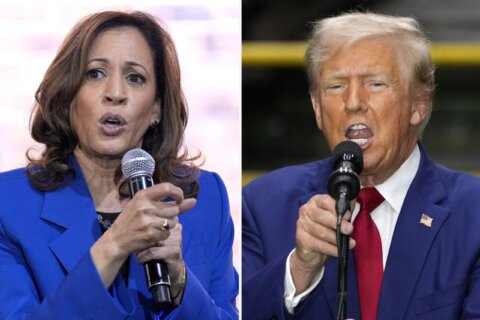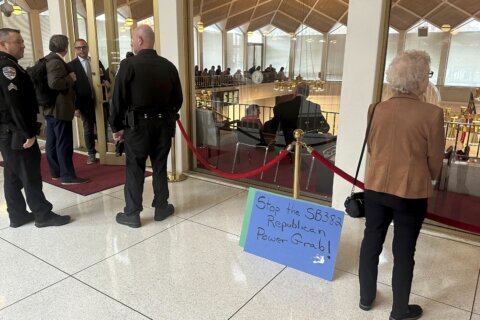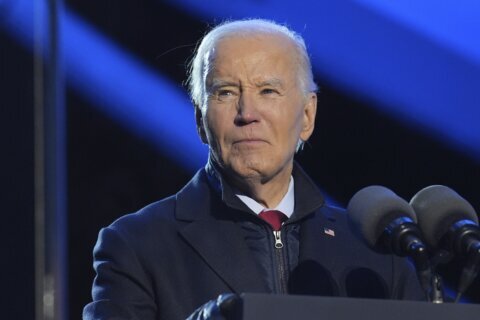VILNIUS, Lithuania (AP) — Despite economic successes, Lithuania’s center-right coalition could be replaced by the opposition Social Democrats and smaller center-left parties when voters in the Baltic country go to the polls on Sunday.
Strict COVID-19 measures and a migration influx from neighboring Belarus have cast shadows over conservative Prime Minister Ingrida Šimonytė’s government, which took office in 2020.
Although European Union member Lithuania has seen annual double-digit personal income growth and has one of the lowest inflation rates in the 27’nation bloc, most voters don’t seem to be impressed by these factors.
“The situation in the economy is far better than for example during the hardships of 2008-2010, but people rarely attribute the gain in personal wealth to the political leadership” said Nerijus Mačiulis, an economist at Swedbank. He referred to the global financial crisis, which hit the Baltic states hard and led to austerity measures.
Rima Urbonaitė, a political analyst at Vilnius’ Mykolas Romeris University, agreed.
“There’s a lot of disappointment and discontent among voters,” she said. “It is related to numerous crises and shocks and cannot be compensated by economic factors like positive change in purchasing power.”
Šimonytė has faced criticism for strict measures during the pandemic, with many complaining that her government didn’t do enough to help companies during lockdown. And others say thousands didn’t have proper access to health care services.
Šimonytė also has been lambasted for her handling of migrants arriving from Belarus. Lithuania has accused Belarus, its eastern neighbor, and Russia of orchestrating the influx.
A recent survey by pollster Vilmorus says that the Social Democratic Party, led by Vilija Blinkevičiūtė, would get 18% of the votes, while Šimonytė’s Homeland Union would get 9%. Nemuno Aušra, a newly registered party of right-wing politician Remigijus Žemaitaitis, who was impeached earlier this year for making antisemitic statements, would come in at 12%.
The poll, commissioned by the Lietuvos Rytas daily and based on about 1,000 interviews, was published Oct. 4. The margin of error was 3.1 percentage points.
The Social Democrats have ruled out an alliance with Žemaitaitis’ party, meaning that three or four parties, likely small groups representing the political center, will be necessary to form a governing coalition.
“I was voting for the conservatives for my entire life, but this year I’m thinking of giving my ballot to another good party, not to them,” said Darius Mikalauskas, a 51-year-old teacher in Vilnius. “Šimonytė and the entire Homeland Union looks battered, worn out and they would better spend some time on the spare bench.”
A shift to the left wouldn’t bring significant changes to the foreign policy of Lithuania, which also borders Russia’s Kaliningrad exclave to the west and Belarus to the east, analysts say. But the vote comes at a time when Russia’s war in Ukraine is fueling greater fears about Moscow’s intentions, particularly in the strategically important Baltic region.
“In this country, the foreign policy course is determined mainly by the president,” Urbonaite said, adding that “trading one minister with another would not mean significant change in its political course.”
Earlier this year, President Gitanas Nauseda beat Šimonytė in the presidential election and won a second five-year term. Despite widespread criticism and decreasing popularity, the ruling party also won a majority of seats in the European Parliament election.
In 2020, the southernmost Baltic country of nearly 3 million saw Šimonytė take her Homeland Union to victory in the parliamentary election. She later formed a coalition with two liberal parties, the Freedom Party and the Liberal Movement.
Four years later, Lithuanians return to the polling stations for a first round.
About 2.4 million people are eligible to elect 141 members of the parliament, or Seimas, for a four-year term in two rounds. On Sunday, 70 lawmakers will be elected by party lists joined by those in single-mandate constituencies who manage to win more than 50% of votes. The runoff is Oct. 27, when the majority of single-member constituencies will vote to choose between the two leading candidates.
Copyright © 2024 The Associated Press. All rights reserved. This material may not be published, broadcast, written or redistributed.







